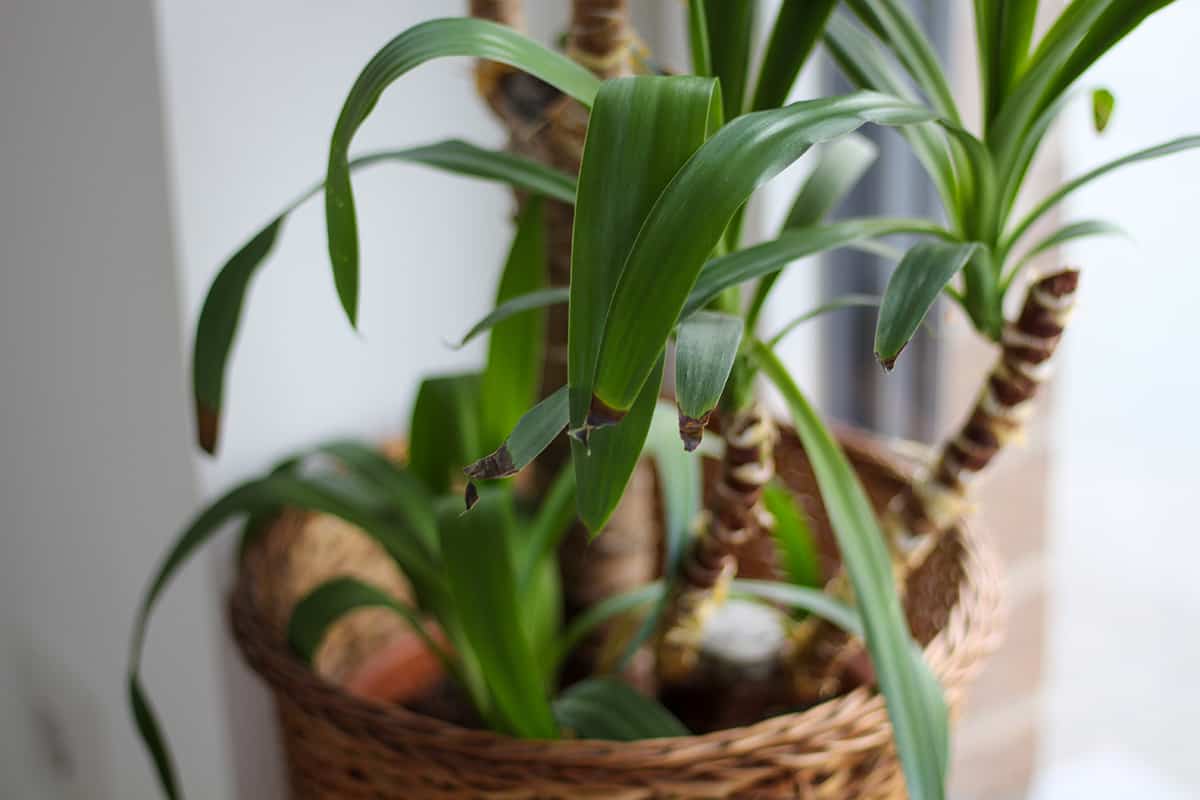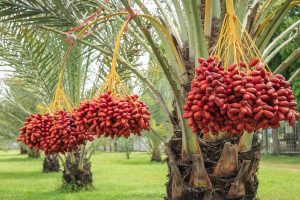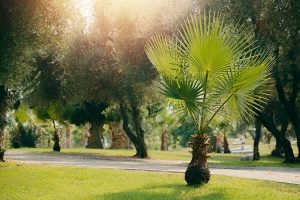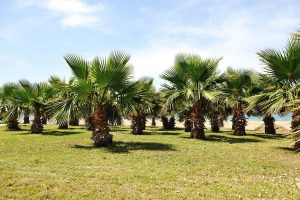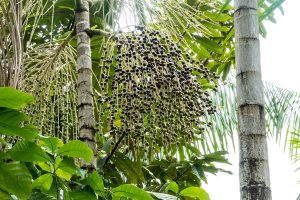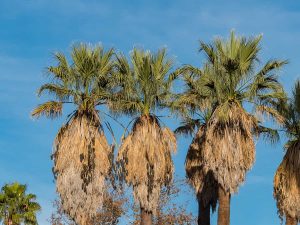Palm trees are susceptible to a number of diseases, with some palms being more vulnerable than others. Here we reveal the key identifying factors of various palm tree diseases and what you can do to protect your tree or manage the disease.
Table of Contents
Disease Resistant Palms
If you want to avoid palm tree diseases then you can opt to plant a palm which is known to be disease resistant. Disease-resistant palms include Fishtail palms (Caryota spp.), Majesty palms (Ravenea rivularis), Triangle palms (Dypsis decaryi), Lady palms (Rhapis spp.), and Guadalupe palms (Brahea edulis).
Identifying and Managing Common Palm Diseases
Diamond Scale
Scientific Name: Phaeochorospsis neowashingtoniae
Diamond Scale is named after the tell-tale diamond-shaped marks which appear on infected trees. These marks will be black and hard and protrude slightly from the tissue of the tree.
In spite of the name, this disease is caused by a type of fungi rather than a pest. This disease primarily affects the California fan palm (Washingtonia filifera), and types of hybrids which have been crossed with this palm are also vulnerable, such as the California and Mexican fan palm hybrid (Washingtonia × filibusta).
Symptoms:
The black, diamond shape marks on a palm are the key indicator of the presence of this disease. Other symptoms may be more noticeable at first, such as the premature yellowing of older leaves and leaves toward the bottom of the palm. Another indicator of Diamond Scale is a reduced canopy, caused by the fact that leaves will prematurely die back.
Management:
The best way to help California fan palms avoid Diamond Scale is to keep them in top condition. This can be achieved with regular watering throughout the year, especially in dry periods. Fertilizer should also be applied routinely to encourage vigorous growth. When palms are in excellent health or have rapid growth, they are less likely to succumb to this disease.
Alternatively, in areas where Diamond Scale is a major problem, avoid planting California fan palms and instead choose disease-resistant varieties such as the Chinese windmill palm (Trachycarpus fortunei) or the Australian fountain palm (Livistona australis).
Fusarium Wilt
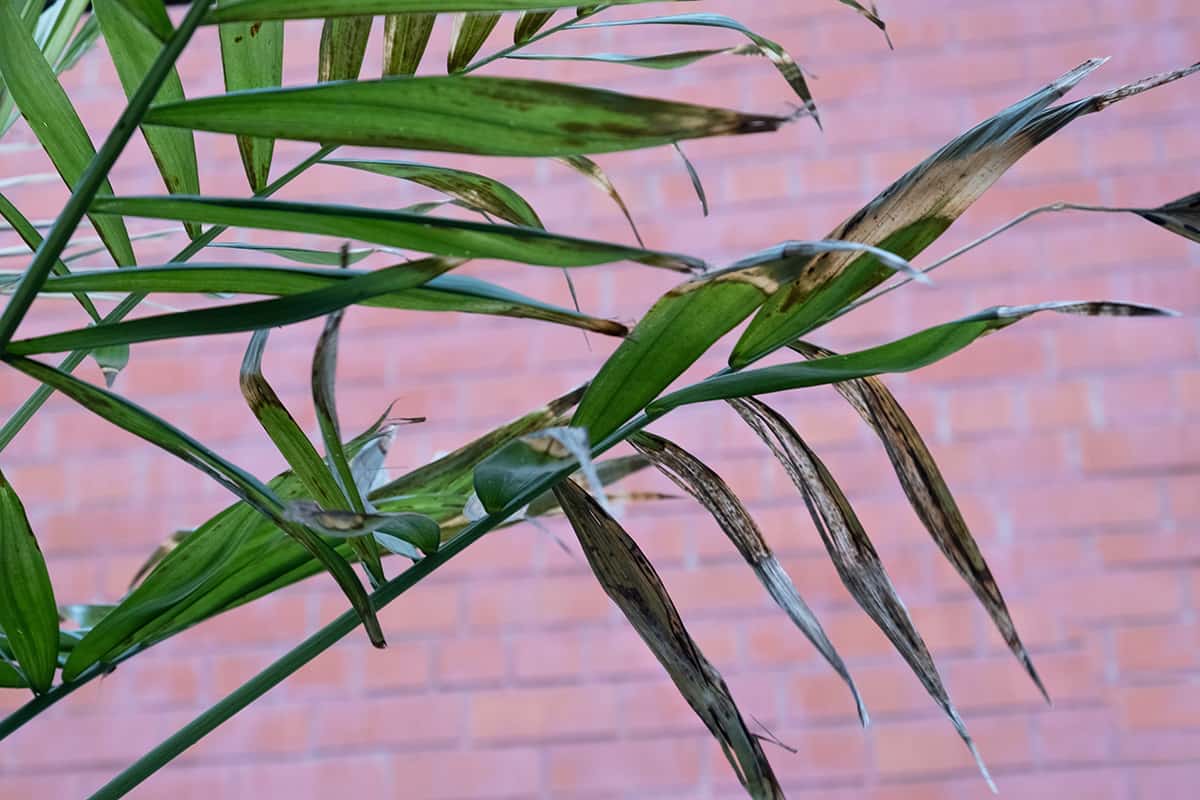
Scientific Name: Fusarium oxysporum
This is a fungal disease that attacks the vascular system of the palm it inhabits. This results in the palm struggling to take in water. The disease primarily affects the Canary Island date palm (Phoenix canariensis), but it can also be problematic for the Senegal date palm (Phoenix reclinata) and the California fan palm (Washingtonia filifera), as well as other types of date palms and fan palms.
Symptoms:
Symptoms of Fusarium Wilt include the premature yellowing and browning of the canopy, and the dead leaves will then remain hanging from the palm. If dead leaves are pruned away, the canopy of a palm with Fusarium Wilt will look dramatically reduced.
Though Fusarium Wilt can present in a similar way to several other palm diseases, the key indicator that helps us recognize this disease is the prevalence of dead and dying leaves. Palms with Fusarium Wilt tend to have significantly more dead and dying leaves than comparable diseases.
This is a fatal disease that can kill a mature palm tree in just a few months. It works by preventing the palm’s uptake of water, killing it from the inside. Because of this, palms with Fusarium Wilt, which are growing in coastal or humid climates, typically last longer than palms with this disease which are in very dry areas.
Management:
There is no cure for Fusarium Wilt, so prevention is the best means of management. The fungal spores are commonly spread on gardening tools such as chainsaws, spades, and shears, so vigilance when it comes to cleaning tools between treating each specimen is essential. Palms which are pruned are significantly more likely to be infected, so if possible, avoid pruning at all.
If you must prune, use hand tools rather than a chainsaw because they are much easier to effectively disinfect. If a tree is diagnosed with Fusarium Wilt, there is no way to save it. To prevent the spread of the disease, remove the tree as soon as possible, with the entire root ball still attached.
Petiole or Rachis Blight
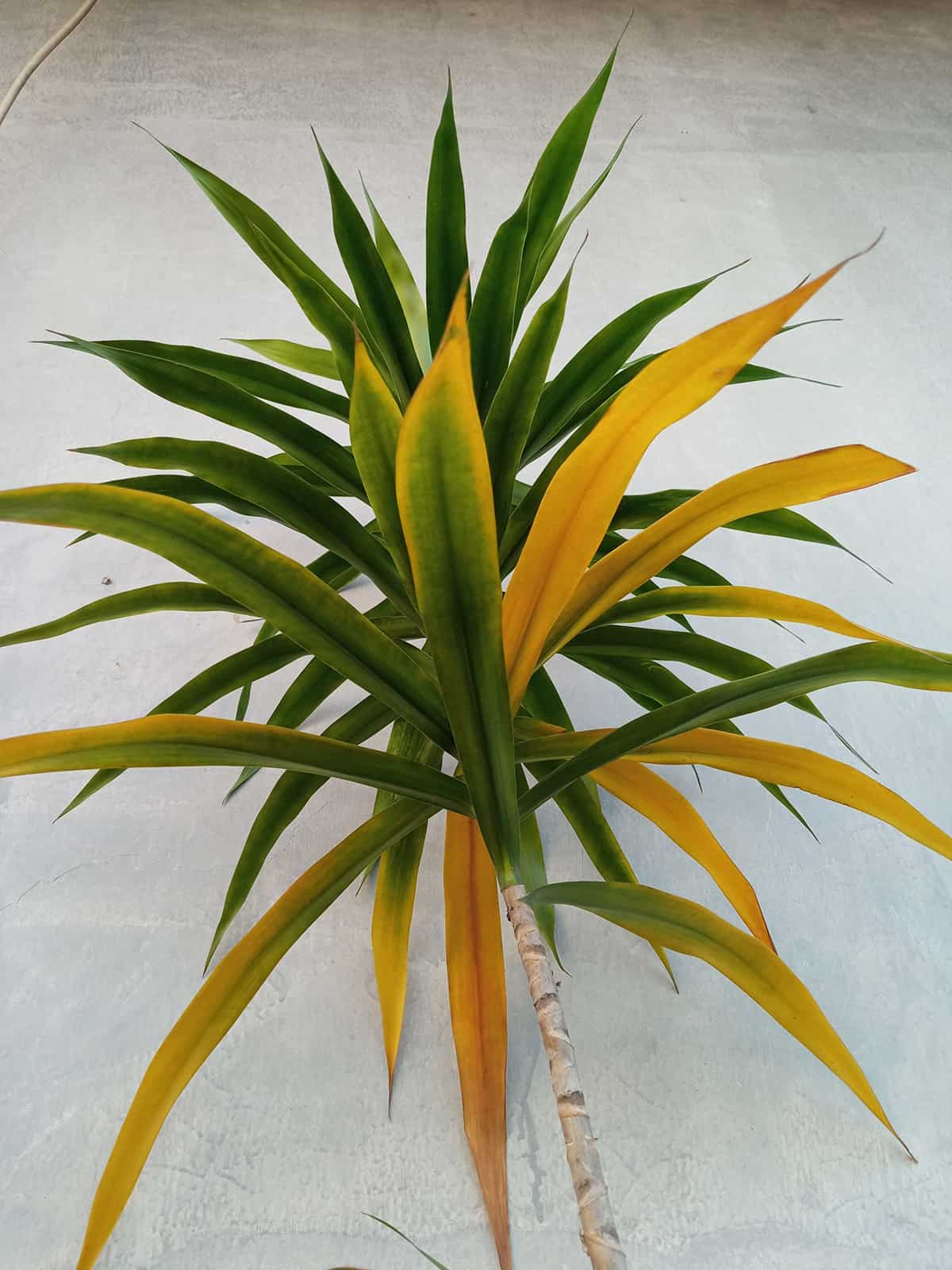
Scientific Name: Cocoicola and Serenomyces spp.
This disease is most prevalent in California fan palms (Washingtonia filifera) and Mexican fan palms (Washingtonia robusta), though it will also attack Canary Island date palms (Phoenix canariensis), Date palms (Phoenix dactylifera), Senegal date palms (Phoenix reclinata), and Pygmy date palms (Phoenix roebelenii). It affects the petiole of the palms, which is the stem that holds the leaf, or the rachis of the palm, eventually causing the entire leaf to die back.
Symptoms:
Palms with Petiole or Rachis Blight will exhibit yellowing or browning on one side of a leaf, amongst those leaves that are pinnate. Typically only a few leaves at a time will become affected, making the disease quite difficult to spot. This is not usually a directly deadly disease. However, it stresses and weakens the tree to the point that it becomes very vulnerable to other deadly diseases.
Management:
Petiole and Rachis Blight favor humid conditions, as they allow fungal spores to spread more easily. To reduce the prevalence of this disease, do not plant susceptible palms in humid climates, and avoid watering the palms from overhead because this will cause increased humidity around the leaves. Instead, water at the soil level, and encourage a high level of health with regular irrigation and the use of fertilizer.
Pink Rot
Scientific Name: Nalanthamala vermoeseni
Pink rot affects almost all types of palms grown in North America, including the Bamboo palm (Chamaedorea spp.), the Chinese windmill palm (Trachycarpus fortunei), the Kentia palm (Howea forsteriana), the King palm (Archontophoenix cunninghamiana), and the Queen palm (Syagrus romanzoffiana). It is a very weak pathogen that will struggle to attack healthy palms and instead thrives on palms that are already stressed or weakened by other diseases.
Symptoms:
Pink rot presents itself in many different ways, including the sudden death of newly emerged leaves, spotting on any part of the tree, and discolored or distorted leaves. The disease can cause any part of the palm to rot, and eventually, it will die.
Management:
The spores that spread pink rot travel easily in the wind and water, so disposing of infected palms is not going to prevent the spread of this disease. Instead, maintaining palms to ensure excellent health is the best defense against pink rot, because it won’t be able to affect strong trees.
To do this, avoid damaging the palm during pruning or maintenance, irrigate and fertilize regularly, and avoid tearing leaves from the palm, which can create wounds where the fungal pathogens can gain access. Pink rot prefers humid environments, so palm trees in humid climates such as the coast are going to be more susceptible. Avoid watering palms from overhead as this will increase humidity, and don’t grow palms in greenhouses where humidity is very high.
Sudden Crown Drop
Scientific Name: Thielaviopsis paradoxa
This disease most commonly affects Canary Island date palms (Phoenix canariensis) and Date palms (Phoenix dactylifera). It is a dramatic disease that silently weakens the tree from within with few or no symptoms, to the point that the crown will suddenly completely drop away from the trunk without warning.
Symptoms:
One of the biggest problems with this disease is that it does not reveal any symptoms in the affected trees until it is too late. The pathogens cause rot and decay on the inner parts of the trunk, which cannot be seen from the outside. The leaves remain healthy and green right up until the time when they suddenly fall from the tree.
Because Sudden Crown Drop is usually not diagnosed until it is too late, it’s important to test palms for this disease on an annual basis. The sudden dropping of an entire crown of palm leaves can present a significant hazard, so vulnerable palms need to be monitored for the disease.
Management:
Pruned palms are significantly more vulnerable to Sudden Crown Drop compared with those which are not pruned, and among the pruned palms, those which have been treated using a chainsaw are more at risk. To prevent this disease, avoid pruning palms, and if this is not possible, ensure the use of clean, disinfected hand tools rather than chainsaws.
You can check if a palm tree is likely to be suffering from Sudden Crown Drop by testing it with a heavy mallet with a rubber head. Hit the trunk of the tree with the mallet and assess the result. In a healthy tree, the strike with the mallet should result in a sharp and solid sound, and you should be able to feel the mallet bouncing back from the trunk.
If there is decay in the trunk, you will hear a low thud when the mallet strikes the tree, and the mallet won’t bounce back as strongly. If the mallet test indicates decay in the trunk, you can probe the tissue within the trunk and get it analyzed to reveal the extent of the problem. Since palm trees with this disease will ultimately die, it is best to have the tree removed in its entirety before the disease progresses to the point that the crown is suddenly shed.
